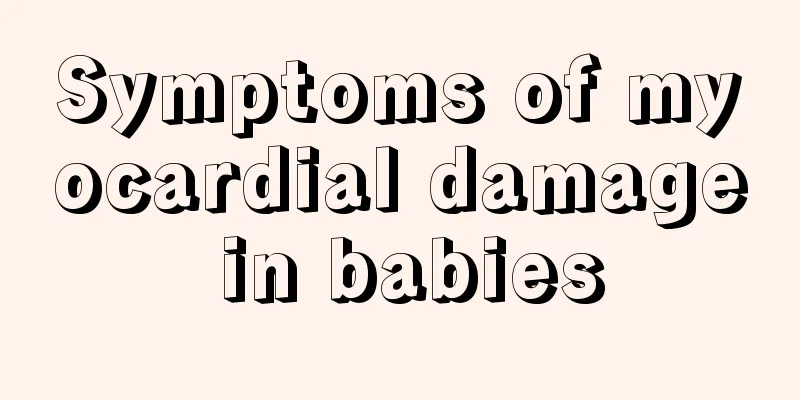Symptoms of myocardial damage in babies

|
Myocardial damage in children is a relatively common disease at present. Most of them can be diagnosed with cardiomyopathy, congenital heart, valvular heart disease and myocarditis. It is usually caused by infection, arrhythmia or coronary artery disease. After the onset of the disease, long sighs will often occur, the face is relatively pale, and the symptoms will be different from those of normal people. They will often feel tired, but the symptoms will not be too obvious. Myocardial damage in children is currently the most common diagnosis in cardiovascular clinical practice. It includes myocardial involvement caused by various reasons, and cannot be clearly diagnosed clinically as myocarditis, cardiomyopathy, congenital heart disease, valvular heart disease and other diseases. They are collectively referred to as myocardial damage clinically. It is often caused or complicated by infection, arrhythmia, coronary artery disease, hypoxia, poisoning (drugs and poisons), metabolic diseases, neuromuscular diseases, blood diseases, etc. 1. Symptoms The main symptoms are long sighs, shortness of breath, and slightly pale complexion; some older children may complain of precordial discomfort, chest tightness, and fatigue after activities; or there may be no symptoms. 2. Physical signs There are no obvious positive signs. Cardiac examination usually shows no obvious abnormalities, the heart borders are normal, the heart sounds are strong, and some patients may have tachycardia, bradycardia, or premature beats. 3. Laboratory Examination Serum myocardial enzymes (aspartate aminotransferase GOT, creatine phosphokinase CPK, creatine phosphokinase isoenzyme CK-MB, lactate dehydrogenase LDH) can all increase in the acute phase, but the increase of CPK and CK-MB is more meaningful for the diagnosis of myocardial injury. Serum troponin (Tn) is often negative. Electrocardiogram: Myocardial damage electrocardiogram changes are non-specific, and various types of electrocardiogram abnormalities may occur, but none of them are as severe as those of myocarditis. Electrocardiogram changes: Common mild T wave changes, ST There may be segment deviation (limb leads <0.05mV< span="">, chest leads <0.1 mV), low QRS voltage, and arrhythmias: such as occasional premature beats, type I0 or II0I atrioventricular block, intraventricular block and other milder ECG changes. (The ECG diagnostic criteria for myocarditis are: ST-T changes in 2 or more main leads (I, II, aVF, V5) dominated by R waves lasting for more than 4 days with dynamic changes, sinoatrial block, atrioventricular block, complete right or left bundle branch block, coupled rhythm, polymorphic, multi-source, paired or parallel premature beats, ectopic tachycardia caused by non-atrioventricular node and atrioventricular reentry, low voltage (except newborns) and abnormal Q waves.) Echocardiography shows normal heart structure and contractile function. Minimal pericardial effusion |
<<: Symptoms of teething in babies
>>: Symptoms of heart muscle damage in children
Recommend
What can children eat to get better quickly from a cold and cough?
When children have a cold or cough, of course we ...
What to do if a 3-month-old baby has a stuffy nose?
With the end of autumn, the temperature will slow...
Can a 14-year-old wear a facial mask?
Making facial masks is the main way people take c...
What is the reason for phlegm in the child's lungs?
Phlegm in children's lungs is usually caused ...
What are the reasons why one-year-old babies cry at night?
Babies cannot express their emotions, nor can the...
What to do if your child has a fever
Children are very lively and active, and often pl...
There is a white spot on the child's face in summer
Summer is the peak season for diseases, let alone...
Baby always chokes and coughs while sleeping
The baby is young, weak, and his organs are not f...
What to do if your child is clingy
Children have many different personalities, and m...
Treatment for red and swollen eyes in children
Nowadays, the incidence of diseases among many ch...
What should I do if my baby is seriously zinc deficient?
Recently I found that my baby doesn't like to...
The cause of polio is actually like this
Polio is one of the diseases with a relatively hi...
What to do if it is difficult to feed medicine to your baby
When a baby is sick and feels uncomfortable, and ...
Can children get vaccinations for coughs?
The recent fake vaccine incident has caused panic...
What is white ringworm on a child’s face?
Generally speaking, children's skin is relati...









